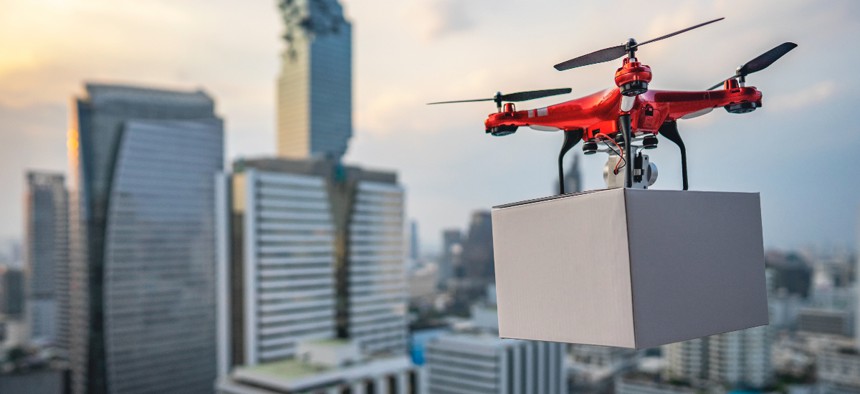NASA Tests Autonomous Aircraft Decision Tech in Arizona Cities

Prapass Pulsub/Getty Images
The agency is aiming to help air vehicles respond to anomalies—such as weather changes—faster, as the vehicles are used to provide essential services.
NASA is performing simulated testing of its autonomous aircraft decision technology in cities to improve and address challenges to airborne mobility, particularly in urban settings, according to an announcement on Friday.
NASA’s Data and Reasoning Fabric—or DRF—project “designs technology to help autonomous airborne activities safely meet their full potential for society’s benefit. Its intent is to form a connected, interwoven ‘fabric’ of intelligence that sends aircraft specific, tailored information, wherever they are.”
The technology is being tested for the first time in February and March in a simulated urban area modeled after Phoenix, Arizona. The project is intended to reduce airspace congestion and increase safety in cities, while helping to bring needed services to people. The project will help address the challenges of tall buildings, local microclimates and high winds in a city. The DRF technology will put together data from various providers and apply artificial intelligence “to make sense of the complex and dynamic airspace.”
According to NASA, autonomous aircrafts’ decisions could be made similar to a smartphones’ navigation app in the future by taking different data into consideration and guiding such crafts to the best route. As a result, the agency noted that “the web, or ‘fabric,’ of intelligence enabled by DRF will provide critical information to operators and autonomous aircraft, wherever they are, to make decisions in time.”
NASA partnered with Autonomy Association International, academia, industry, government, communities, tribal nations and more than 22 cities in Maricopa, Penal, Pima and Yuma counties in Arizona.
The Phoenix test is looking at different situations where the DRF technology could be useful, studying the scenarios in the context of a simulated drone flight to deliver medical equipment and supplies from downtown Phoenix to the outermost areas of the greater region. According to NASA, scenarios in the future could include insulin delivery for people living in areas with limited healthcare or to reroute an air taxi during a sudden dust storm.
“This activity can help providers of data and decision-support services better understand the needs of future airspace users and the benefits of DRF,” said Kenneth Freeman, DRF’s principal investigator at NASA’s Ames Research Center in California’s Silicon Valley. “Users are able to compare multiple services to select the one that fits their needs: weather data from this source, air traffic updates from another. With further development, we expect this model to potentially drive innovation in the industry, which could lead to improvements in the quality of airspace services.”
NASA stated that participants are utilizing the DRF-enabled digital ecosystem to determine their ability to select data and services to support safe and autonomous flight. The current field tests examine how well the system can help reroute an aircraft because of anomalies like communication disruptions, an unexpected object in the flight path and weather changes. In these cases, DRF can alert an aircraft approaching an anomaly and connect them to the appropriate service for assistance to respond quickly.
According to the agency, DRF technology was previously tested by the Civil Air Patrol in California to demonstrate the possibility of using DRF to fast-track airborne emergency response. Furthermore, using simulated drone flights, it helped to locate lightning-induced wildfires faster than usual.
DRF uses edge computing—a system handling, processing and storing data locally, at the ‘edge’ of a network instead of in the cloud or data center—to minimize delays with the transmission of large data sets and enable faster decisions.
NASA noted that researchers across the agency are conducting advanced air mobility studies to support new transportation. Specifically, the data and AI-assisted decision support tools helped by DRF will provide information necessary for future flight operations. NASA stated that, in the future, the air transportation system will include low-altitude passenger travel, cargo delivery and public service capabilities. Accordingly, the agency is providing data to guide electric air taxi and drone development as well as help the Federal Aviation Administration safely integrate said transportation vehicles into the airspace.
NASA stated it is looking to address and support the needs of autonomous flights and their digital ecosystem as air transportation continues to improve.






